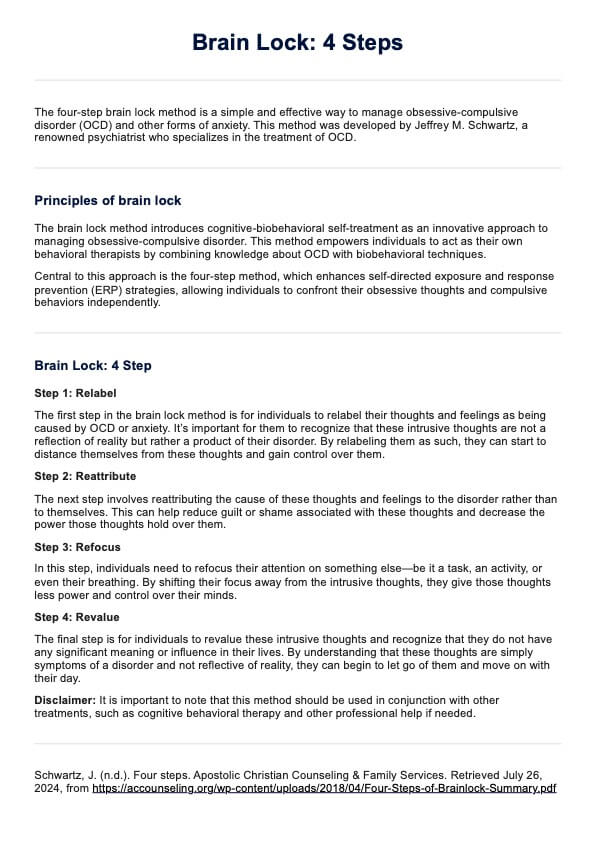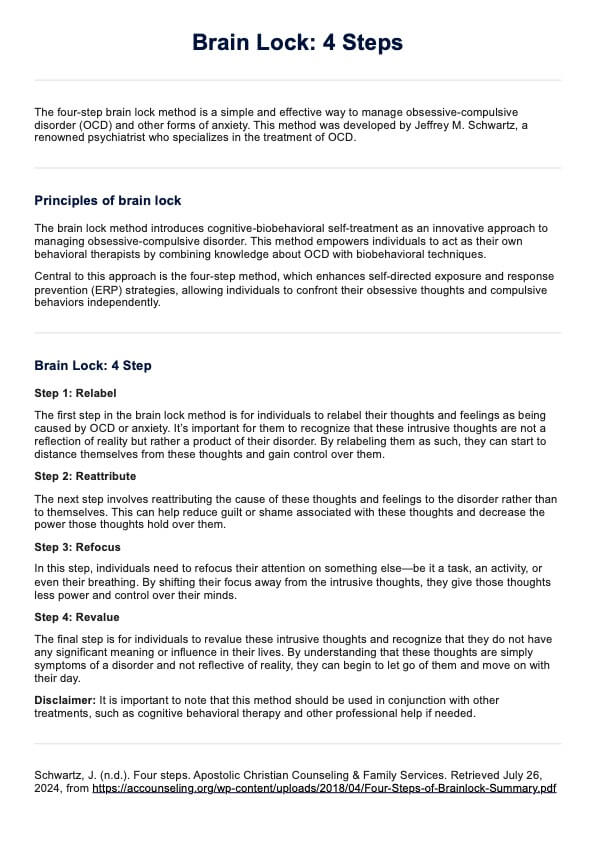Brain Lock: 4 Steps PDF
Our comprehensive PDF guide teaches you the 4-step brain lock method. Master techniques to help patients effectively overcome OCD and regain control.


What is obsessive compulsive disorder (OCD)?
Obsessive-compulsive disorder (OCD) is a mental health condition marked by obsessive-compulsive behavior. It involves intrusive thoughts (obsessions) and repetitive behaviors (compulsions), which cause significant distress and uncomfortable feelings that interfere with daily life. Individuals with OCD often recognize the irrational nature of their obsessions or compulsive urge to do something but feel compelled to perform certain actions to alleviate anxiety or regain control in a situation when they feel helpless.
Common obsessions
- Fear of germs or contamination
- Fear of losing or misplacing something
- Unwanted thoughts related to sex, religion, or violence
- Aggressive thoughts toward oneself or others
Common compulsions
- Excessive cleaning and handwashing
- Repeatedly checking if doors are locked or appliances turned off
- Arranging items in a precise way
- Compulsive counting
Healthcare providers diagnose OCD by evaluating the presence of obsessions and compulsions according to Diagnostic and Statistical Manual of Mental Disorders fifth edition (DSM-5 criteria). Treatment typically involves cognitive behavioral therapy (CBT), particularly Exposure and response prevention (ERP), and medications like selective serotonin reuptake inhibitors (SSRIs). Early intervention is crucial for overcoming OCD and improving mindful awareness and quality of life.
Brain Lock: 4 Steps PDF Template
Brain Lock: 4 Steps PDF Example
What is brain lock?
Brain lock is a concept introduced by Dr. Jeffrey Schwartz to describe the cyclical nature of obsessive thoughts and compulsive behaviors in OCD. Brain lock explains how an intrusive thought becomes entrenched, creating a feeling of being mentally "locked" into distressing patterns or feelings like very low self-esteem. Brain lock occurs due to hyperactivity in specific brain regions, particularly those involved in anxiety regulation and behavioral control.
This leads to persistent feelings of anxiety and generates repetitive behaviors as individuals attempt to alleviate their discomfort or painful circumstances. Individuals may feel they are living diminished lives, ensnared in psychic prisons of their own making. However, cultivating mindful awareness can help break this cycle of fatiguing exertions, allowing individuals to recognize and manage their OCD thoughts more effectively and develop new patterns.
What are the four steps of brain lock?
Dr. Schwartz’s simple four-step method offers a structured approach to cognitive self-therapy for managing OCD symptoms for those who live diminished lives caused by it:
1. Relabel
By consciously naming these thoughts "OCD thoughts," individuals can begin to detach themselves from the emotional weight that accompanies them. This relabeling step is crucial in understanding that these thoughts are not inherently true or reflective of reality.
2. Reattribute
Understand that OCD causes these thoughts and urges. Acknowledging the underlying neurobiological basis for these thoughts is key to reducing the perceived significance of the obsessions. The reattribute step enables individuals to view their experiences through compassion and understanding.
3. Refocus
Redirect attention away from obsessive thoughts and compulsive urges. It’s essential to engage in constructive activities that can effectively break the cycle of OCD. This step encourages individuals to find healthier outlets and distractions.
4. Revalue
Reassess the importance of obsessive thoughts and compulsive behaviors. This step encourages individuals to view these thoughts and behaviors as insignificant and unworthy of attention. It’s about redefining their relationship with these symptoms.
By systematically applying these four steps, individuals can develop a more resilient mindset and effectively manage their OCD symptoms, ultimately leading to a more fulfilling and balanced life. However, it's important to note that this method should be used in conjunction with other treatments like cognitive behavioral therapy, and other professional help if needed.
How does our Brain Lock: 4 Step PDF work?
Our Brain Lock: 4 Steps PDF is a quick handy reference you can use in your practice for your patients. Here's how to get started:
Step 1: Download the template
Get a copy of the Brain Lock: 4 Steps PDF and save it to your computer or tablet. It's easily accessible and can be used at any time, making it a convenient tool for both patients and healthcare professionals.
Step 2: Identify obsessive-compulsive behaviors
Help your patient identify their specific obsessive-compulsive behaviors by having them fill out the worksheet. This will help them become more aware of their thoughts and behaviors that may be contributing to their symptoms.
Step 3: Follow the four steps outlined in the handout
The Brain Lock: 4 Steps PDF outlines the four steps of thought and behavior modification that can help patients overcome their obsessive-compulsive behaviors. Encourage your patients to practice these steps regularly and self-monitor their progress.
Benefits of using this Brain Lock: 4 Step PDF
The Brain Lock: 4 Steps PDF is an efficient tool for both patients and healthcare professionals in managing obsessive-compulsive behaviors. Here are some specific benefits:
- Easy to follow format: The step-by-step format of the handout makes it easy for patients to understand and follow along.
- Convenient: The PDF can be downloaded and accessed at any time, making it accessible whenever needed.
- Self-guided: Patients can use the handout on their own as a self-help tool, promoting independence and empowerment in managing their symptoms.
- Time-saving: The concise and straightforward nature of the handout saves time for both patients and healthcare professionals in therapy sessions.
Tips on implementing the four-step method in your practice
Introducing the four-step method into your practice provides a systematic approach that promotes consistency and empowers individuals to take control of their symptoms.
- Educate patients on the four steps: Provide clear explanations and examples to ensure understanding.
- Use real-life examples: Share case studies or personal anecdotes to illustrate how the steps can be applied in everyday situations.
- Encourage consistent practice: Suggest journaling to track thoughts and responses and stress the importance of regular practice.
- Create a supportive environment: Foster open communication and positive reinforcement for efforts and progress.
- Monitor progress: Use standardized assessments to measure changes and adjust strategies as necessary.
- Address challenges: Discuss potential obstacles and develop strategies to overcome them.
- Incorporate mindfulness techniques: Teach mindfulness exercises to help manage anxiety and improve focus.
- Provide resources: For further support, recommend additional reading materials, such as Schwartz's book Brain Lock and online resources.
Commonly asked questions
The four steps in brain lock are: relabel, reattribute, refocus, and revalue.
Obsessive-compulsive disorder (OCD) has four stages: obsession, anxiety, compulsion and relief.
EPR therapy is best done under the guidance of a trained therapist, but some people may choose to do it on their own with proper research and resources.

.jpg)


















-template.jpg)



















































































